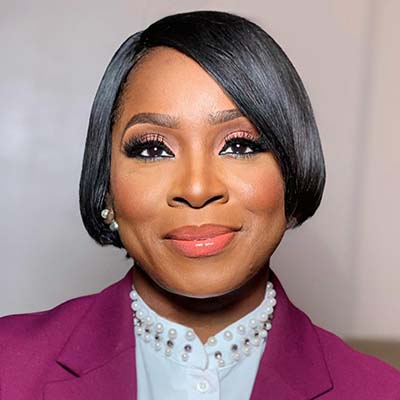

- Janet Legge
- Deputy Chief Executive, The Association of Corporate Treasurers (ACT)

- Kemi Bolarin
- Head of Treasury – Europe, GXO

- Tom Alford
- Deputy Editor, Treasury Management International
Following the recent row-back by certain US corporates on their DEI programmes, we explore the possible impact of curtailments through the eyes of those who have worked to establish them, and ask if it’s time for a rethink?
Starting in 2024, a number of US firms announced cutbacks to their diversity, equity, and inclusion (DEI) programmes. This was reported as being driven in part by activist investor pressure to adopt corporate neutrality on divisive issues. The trend has continued into 2025 with a number of corporate American giants, including Amazon, Meta, McDonald’s and Walmart, scaling back or cutting their public commitment to DEI. More recently in the US, Goldman Sachs and Deloitte have decided to abandon their diversity initiatives.
In the US, there seems to be some realignment of corporate priorities towards a new political, cultural, and legal landscape led by President Donald Trump. But employees too are divided on DEI’s value. An online survey, conducted in January 2025 on the Blind anonymous business community website, found that among 965 verified Meta employees, 44% viewed DEI as having a positive impact on the company but 38% saw the firm’s initiative negatively.
While DEI programmes are largely implemented on a voluntary basis, they are to an extent underpinned by legal frameworks in many countries. In the UK, the Equality Act 2010 was established to provide legal protection in the workplace for nine protected characteristics. These are: age, disability, gender reassignment, marriage and civil partnership, pregnancy and maternity, race, religion or belief, sex and sexual orientation.
While the meaning of DEI might seem obvious to many, for the purposes of clarity employment solicitors Springhouse Solicitors suggest that in this context equality is about “eliminating discrimination in the workplace and ensuring equal access and equal opportunities for all”. Diversity “recognises difference and creating a workplace culture which respects, values and utilising all differences”. Inclusion is “generally accepted as the practice of accepting someone as they are – breaking down prejudice and challenging attitudes – and making changes accordingly”.
Victim of its own success
With many companies having invested in DEI, developed their policies and built teams around it, any significant programme curtailment could be disruptive, whether they chose to follow the US or not, suggests Kemi Bolarin, Head of Treasury - Europe, GXO. “It makes people nervous as to where they stand. Even people in the groups that DEI is intended to recognise and include within an organisation are probably wondering what this might mean.”
Somewhat ironically, the widespread adoption of DEI has, she feels, been its key weakness. With many programmes underway, the distinction between the genuine belief and the box-ticking exercise may not be immediately apparent. For those that do not see the value or feel the benefit of DEI, the opportunity to malign its practice or dispense with it altogether is now being taken.
But far from despairing, Bolarin believes the current inflection point to be an opportunity, even for individuals that belong to so-called ‘protected’ groups (she does not use the word herself). There is now the possibility to establish that DEI “should actually be about inclusivity for all”. While this subtle shift in emphasis might cause ructions even in some established well-meaning programmes, she feels ultimately it will strengthen their value because it will strip away any perceived political agenda.
Review, rebuild, retell
DEI programme cessations in the US are being watched by the world, says Bolarin, noting “different interpretations across social media” that may encourage retrenchments to “trickle down to other regions”. But the negatives have been building for some time. She has witnessed DEI’s mistaken reading solely as a race issue, for example. Where employees are tagged as ‘DEI hires’ based on the colour of their skin, she sees “their competence and talent being undermined”.
At the heart of the matter is the efficacy of DEI programme implementation, which, for many corporates, has not been properly thought through nor integrated, suggests Bolarin. Where this is the case – or where DEI has been cynically executed – the impact will fall short for everyone. Abandonment becomes an all too easy way out for those that “chose to manage it as nothing more than a tick-box exercise”.
Some programmes, notes Janet Legge, Deputy Chief Executive, the Association of Corporate Treasurers (ACT), have adopted an almost quota-like approach. “They’ve been driven by numbers and targets, where, for example, they call for 50% of women at senior levels. I think there’s an issue with that model because it’s more akin to an accounting exercise where, if the numbers are achieved, the goal is met. But in practice, it can undermine not just the employee’s abilities, but also the company’s capacity to select the best person for the job.”
However, Bolarin observes programmes that are underpinned by a genuine reflection on the benefits brought to the organisation and the individual. “I’ve seen bold statements from leaders of organisations declaring that DEI is not a department but a business value, and that they understand and embrace the philosophy”.
Of course, most organisations are driven by their bottom line, their behaviours being influenced by this. Global management consultants McKinsey’s 2024 study, Diversity Wins: The Financial Impact of DEI, therefore makes interesting reading for any leader sitting on the fence. It reveals that companies with diverse teams are 36% more likely to outperform their peers in profitability. This, it is suggested, could be because diverse teams benefit from diverse inputs, and are thus better able to understand and reach a wider section of their market.
Indeed, notes Legge, one of the key benefits of having an inclusive workforce is around problem solving. “When you have a group of people that can bring different world experiences, views, and ways of tackling issues, it lends itself to better problem-solving than if everyone approaches it from the same angle. A solution may still be found, but it might not necessarily be the best one because not all angles may have been explored.”
What’s more, she believes that a team dynamic where all are encouraged to share their thoughts and innovate is hugely empowering, and that matters. “We live in a world that is all about innovation. Technology is moving faster than any of us have ever known, and to keep pace we need a wide spectrum of thought and ways of working,” she explains. “I think the only way we’re going to move forward is to have different opinions, different life experiences and ways of working brought to the table.”
Resist the hijackers
Change is par for the course in most industries anyway, says Legge. As such, businesses need to ensure they remain relevant. “So should we do it with DEI? It’s an area that’s changing rapidly, so absolutely yes we should. People respond to DEI in different but often very emotional ways, so now feels like the right time to look at repositioning or redefining what we are trying to achieve with it.”
Bolarin agrees that the current conversation around the value of DEI should be taken up in earnest, even if some agents are clearly trying to change the narrative, hijacking it for whatever ideology they may support.
If organisations and their leaders take time now to reassess what DEI means to them, and what their aims are, it may suggest changes that could bring about a more positive perception and outcome for all. And, Bolarin suggests, change may be as simple as providing more information to stakeholders to show the reasons why their organisation continues to pursue its initiative.
With this in mind, she argues that the role of DEI professionals should now be to accept that certain initiatives have lost sight of their purpose, and that they should begin focusing their efforts on “retelling the story and educating”.
From symbolism to substance
The current backlash against DEI seen in certain geographies is perhaps an unintended consequence of trying to change attitudes without properly considering audience variables. But there may be natural pulses to the way social movements progress, suggests Legge.
“The suffragette movement in the early 20th century went through an intense phase, highlighting women’s rights through public demonstrations and militant actions. Eventually it came up against strong resistance forcing it into compliance for a while, but it never went away. That period enabled the movement to define its goals, regroup, and ultimately come back stronger. We may now be going through a similar reflective phase with DEI.”
If businesses want DEI as a core component of their corporate social responsibility, portraying the value of such a transformative concept requires hard evidence of its value, states Bolarin. “Leaders in organisations should be challenging their DEI teams to provide quantitative data in addition to the broad qualitative reports they often submit,” she advises. “This is the only way it will demonstrate to every stakeholder the reason why DEI is worth pursuing.”
While it might be relatively easy to show how representation of different groups in organisations is changing, ultimately, businesses should also be measuring the impact of DEI on their bottom lines, as per the McKinsey report referenced above. By quantifying their product or service appeal across the widest spectrum of their buyer community, firms will be better able to manage growth, and provide evidence of the commercial value of DEI to those who feel its social value is not enough.
Once a DEI initiative is implemented, the provision of quantitative data should be regular. This enables recalibration from time to time, to ensure continued alignment with core business objectives. The aim is for each DEI programme to quickly shift “from symbolism to substance”, explains Bolarin, adding that “we need to stay committed to change until the goals become part and parcel of life”.
DEI’s evolution from symbolism to substance will thus likely be as much about developing positive perceptions as it will be about satisfying core organisational aims. To achieve this, it may be that companies just need to reframe how they communicate their DEI policy. The perception that DEI results in the inclusion of one group at the cost of another, could more readily be countered by explaining the value to all of a ‘culture of belonging’.
“DEI should never be about divisiveness,” states Bolarin. “But neither should it be blind to people’s differences. Success will come from accepting those differences, and giving them a place and a voice. By enabling employees, customers, suppliers, and other stakeholders, no matter who they are, to be part of the conversation, they will begin to feel like they’re a welcome part of the organisation.”
More than a department
To feed success, DEI teams should not work in isolation; they must be drawn from and embedded across the organisation, from top to bottom, urges Bolarin. In particular, they should be rooted in corporate leadership, because with direct engagement from the top down, DEI becomes linked to the overall structure, ambitions and internal and external perception of the organisation.
But it’s clear that the notion of DEI still has a way to go before it can quietly disappear, its work done. Bolarin understands how the issues and current sensitivities have arisen, some organisations having struggled with its objectives, implementation, and execution.
“DEI cannot just be a ‘department’ or a ‘training course’. It has to be embedded throughout,” she insists. “When this is achieved, companies begin to lead, build trust, retain talent, innovate, and protect all of their employees’ well-being. And they’ll be stronger for it.”
In the treasury world, the ACT is ready to assist its members in establishing effective policy setting, implementation and execution. “We launched the ACT guiding principles in late 2023, the process driven by our members,” explains Legge. “They came to us with the impression that they weren’t seeing diversity among their bank relationship managers. They were keen to drive positive change in the industry, and felt we could help them achieve it.”
The ACT took on the role of facilitator, bringing together those treasurers and senior representatives from a cross section of their banks. Their first meeting was in September 2023, with a follow-up session in January 2025. The meetings were purposefully candid, but conducted under the Chatham House rule. This means anyone who comes to a meeting is free to use information from the discussion, but is not allowed to reveal who made any particular comment. It is designed to increase openness of discussion.
“An interesting issue arose at the first session, with the banks accepting their clients’ comments but highlighting the need to address a similar lack of diversity among those companies’ own ranks,” notes Legge.
With both parties “passionately advocating change”, when the group reconvened, several corporates reported observable differences in the make-up of their teams. “There was certainly a greater willingness to give more junior members an opportunity to participate, providing them with a platform and the support to speak. It suggests a strong desire to improve diversity, with an action-led approach.”
FIG 1: Treasury and bank guidelines
The ACT’s Guiding Principles for diversity and inclusion for interactions between corporate treasury teams and coverage teams in banks encourage members to:
- Make diversity a regular discussion topic in interactions between corporates and their banking partners, encouraging open conversations to progress the diversity agenda across the market.
- Conduct bank meetings in a way which supports inclusive participation. This includes encouraging, and being receptive to, attendance of a diverse range of participants from both sides at client meetings. This should also consider the inclusion of junior team members. Their attendance can be to learn, observe, or participate.
- Understand the institutional policies, aspirations and targets of their banks around diversity, and the timelines involved. Conversations around progress against these should be included in periodic review meetings.
- Where appropriate, provide challenge and constructive feedback to banks around diversity. When doing so, they should assume good intent – and should expect a constructive response.
- Where our members choose to include diversity as a metric in RFPs or other documents, they should be clear with participating banks on their expectations.
DEI in action
The ACT policy is not to be too prescriptive in its approach to DEI, states Legge. “Our ‘guiding principles’ was a major piece of work very much aimed at supporting our members and our network. We’re always looking at different ways in which we can support this initiative and make a positive difference, without being dogmatic.”
The ACT has taken practical steps, having signed up to a DEI pledge with the Federation of Awarding Bodies (FAB) to ensure its qualifications are accessible. Through this it aims to support all members seeking qualifications, with flexibility around how they access course materials and sit exams.
“We also offer DEI sessions for members at our conferences, and often facilitate open and honest conversations in safe spaces. Senior treasurers are leaders in this, signing up to a commitment to encourage and support change. They are actively empowering and motivating their employees, especially juniors, to be able to talk about it.”
While there are changes and challenges for DEI, Legge agrees with Bolarin that the need now is to find and act on the opportunities within this dynamic scenario. “There are organisations that like to talk about DEI, but not do too much, just as there are organisations for whom it is a significant and powerful part of what they are,” she comments.
“But I hope most will take a pragmatic view as to how it works for them as an organisation – how it aligns with their own values, and what it does for them from a financial position – because the bottom line is that diversity creates higher performing teams. It loosens the grip of counterproductive behaviours such as groupthink, and it enhances the financial performance of the company.”


